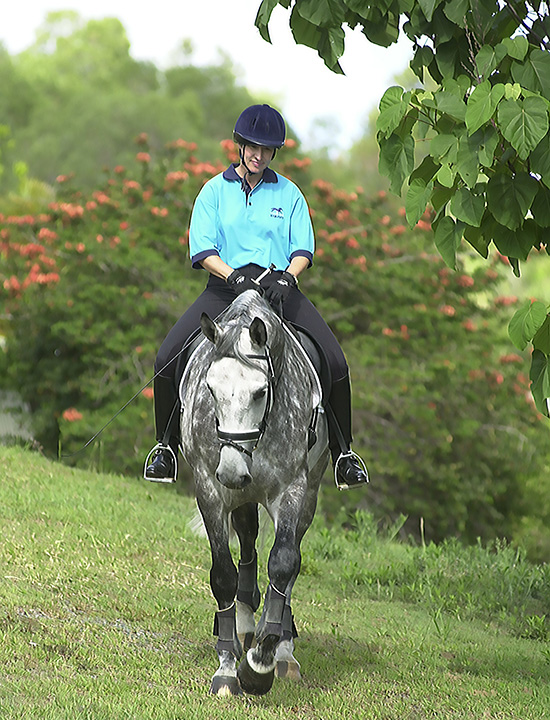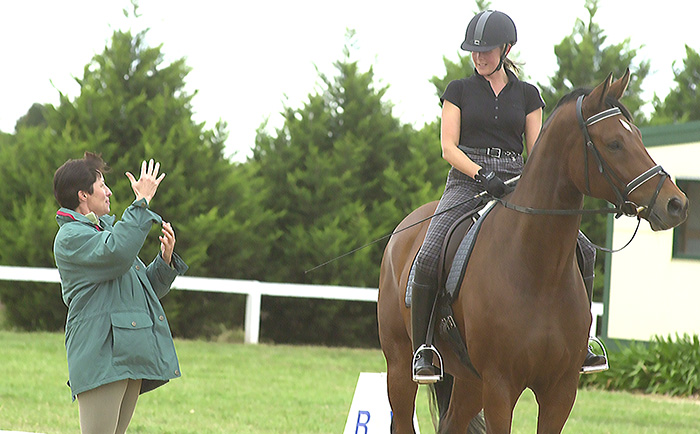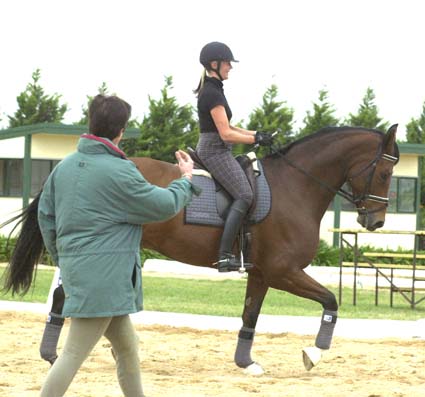From the Archives: Ricky MacMillan and Rebecca Fenner at Werribee Park..
Story – Christopher Hector Photos – Roslyn Neave
Every dressage fan knows Ricky MacMillan the competitor. Riding her Hanoverian gelding Crisp, Ricky has dominated Grand Prix competition over the past twelve months, but fewer know of Ricky the Instructor.
Despite, Ricky’s busy schedule as a dentist, plus riding five horses a day at her Gold Coast home, she is in keen demand as a coach in her home state of Queensland, New South Wales, South Australia and the West. Although it is a tight piece of weekend programming, with Ricky getting up at 4 in the morning on Sunday, to ride, then flying off to teach at a clinic, getting a 2 pm flight back to ride the rest of the horses at 5 in the evening, then jumping out of bed the next day to start another working week!
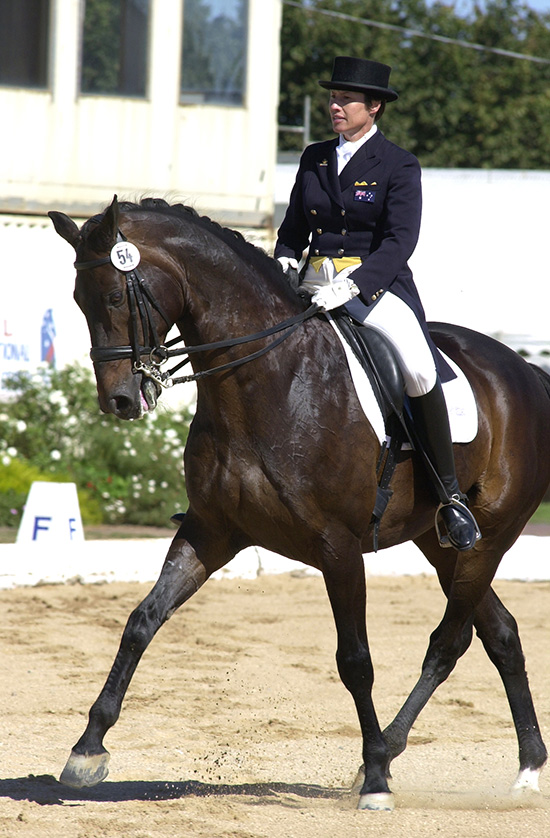
We jumped at the chance to set up a ‘lesson with’ when Ricky travelled south for the Dressage Festival.
And who better for a pupil than Rebecca Fenner and the equine superstar of the moment, Whistler.
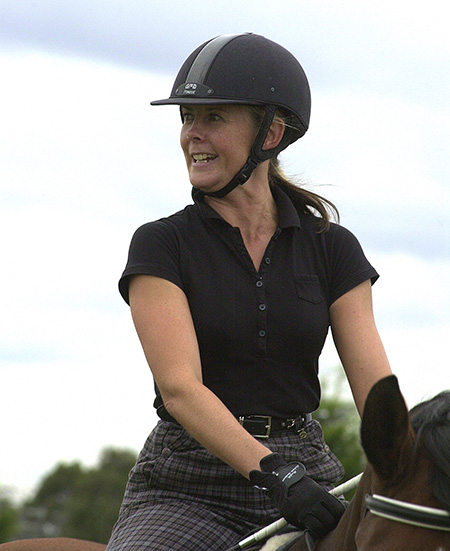
Bec is a wonderfully responsive pupil, and disconcertingly honest when Ricky asks her about any problems: “We can really fall apart in the canter! I feel quite comfortable in the trot; it is in canter when the problems start. The flying changes are alright; I just let it all fall apart a bit. I feel like I’ve got plenty of ‘gears’ in the trot, but I don’t feel I’ve got gears in the canter.”
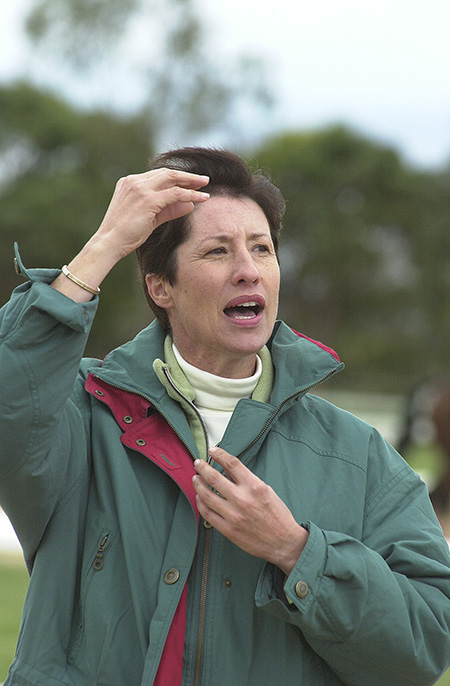
But Ricky – this is no surprise to those who have been lucky enough to meet her in her tooth fairy role – has a gently comforting manner: “You have just arrived at the showground, we want Whistler working willingly and happily with you. Keep him with you, even if you don’t ride him at full power. Don’t be tempted to think of Ros’ camera.”
As soon as Rebecca started cantering the horse, Ricky was onto the problem – and the solution.
“You have to get more throughness in the canter. It is a matter of always trying to go a little more in small stages. Let’s start with some trot…”
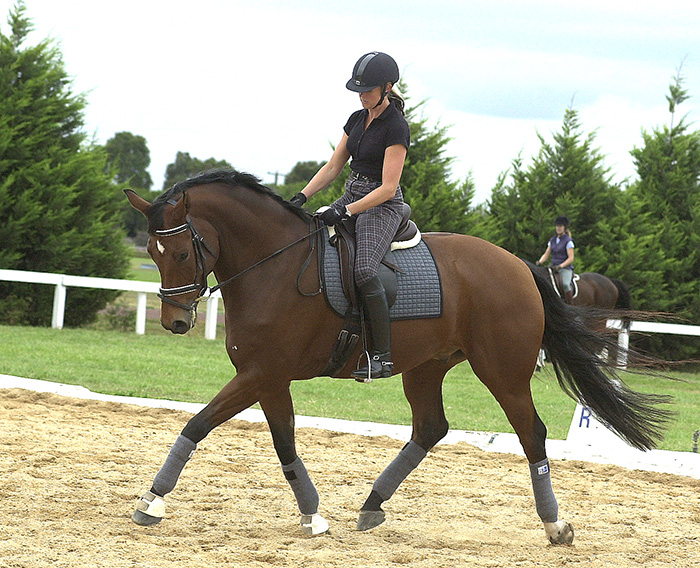
What a glorious trot! Whistler is by one of the best sons of Weltmeyer, Wolkenstein II and was bred by two of our top dressage horse breeders, Jane and Maurice Bruce.
story follows the advertisement
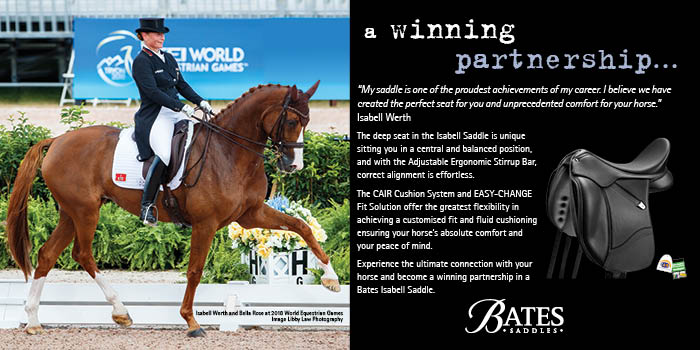

Still Ricky is not quite happy with the rider:
“He looks a little strong in the left hand, better to get him a little more around your inside leg, and give. Well done – but you don’t have to show me that you have given the rein. Just give a tiny bit – I’ll know you’ve done it. Less inside rein, whenever you can, always less. Try on / off with your left rein rather than getting caught with it.”
And into canter: “Try to get him coming up more with the poll – not faster, just up a little more. Let him canter, don’t you work too hard, up more in front. I see what you mean about the gears in canter, he wants to go right forward, or hang back.”
“Don’t get caught being there for him to lean on in the trot and the canter. Poll up, poll up.”
And that is where Ricky worked Whistler and Rebecca for the next fifteen minutes or so, getting the horse more engaged, happier to carry the weight and vary the tempo, and all the time encouraging Bec to get off her troublesome left hand. “Soften your left elbow – don’t think, ‘oh I’ve got to hold myself up’. You soften your left elbow and suddenly he is more active. Remember to half halt on the outside rein.”
story follows advertisement
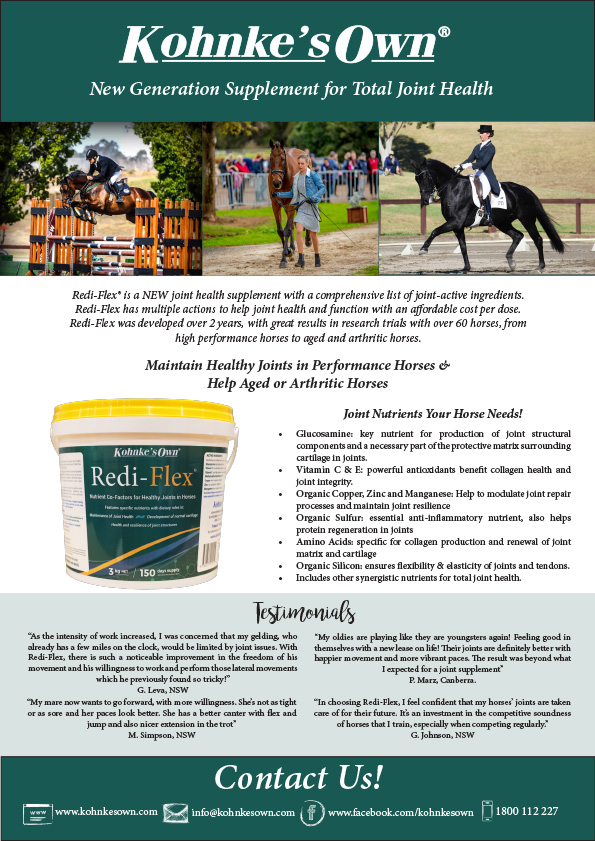
It was time to look at the walk, and what a handsome walk it is: “That’s wonderful, a really clear rhythm. You mustn’t let the walk get too fast. You can lift the frame in the walk, but don’t hold it, you have to say ‘whoa’ and let go again.”
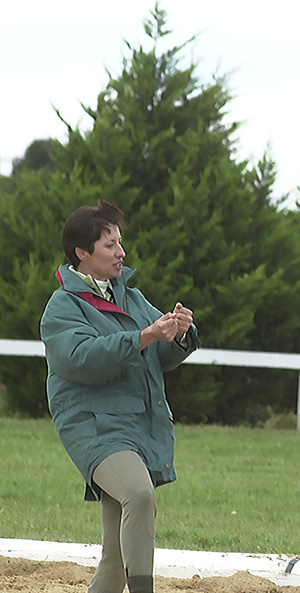
“In your walk trot transition he is not coming under your seat, make him step under you. Let your weight go through to his back – he will carry you.”
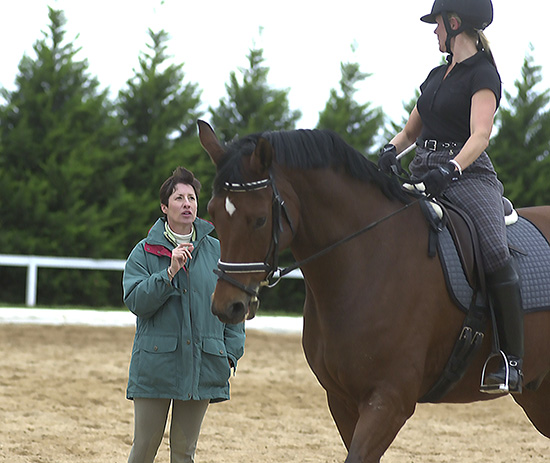
“Keep him up even in the down transitions. SUPER he didn’t even lean in that trot transition.
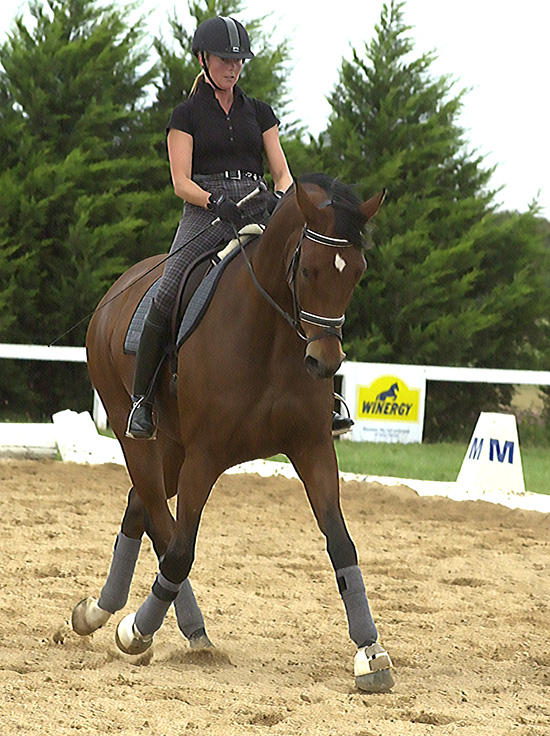
It was time for a little lateral work…
“In shoulder in, think collection, not working trot. Poll up, half halt, keep him steady and give, give, GIVE. He’s trying to roll himself up; you’ve got to get his nose forward. You have to remember when the poll is up, give, and keep him there with your back. Now his nose is forward, keep it there, keep the rhythm, and forward, forward, forward.”
From shoulder in to travers:
“In right travers, keep his hip right up near you, and more forward.”
“In travers on the long side the horse’s left and right eyes should be the same distance from the short side. The same should be true of the nostrils. So often we don’t ask for sufficient impulsion and bending and so allow the horse to look outside the arena. Sometimes we don’t ask for enough impulsion which allows the horse to put too much weight in the outside shoulder and we get head tilting.”
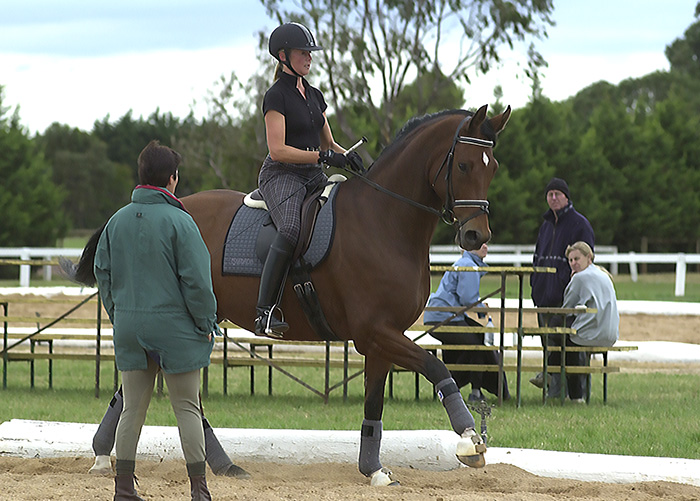
At first Bec didn’t ask for much bend and Whistler’s outside eye and nostril needed to stretch forward to become closer to the short side. To achieve this Whistler needed to step up under Bec’s weight with his right hind.
“I want to see less angle and more bend.”
To make sure of the bend, Ricky had Bec move from travers to a small circle, to travers, and back again.
“Don’t let his quarters come in on the circle… and now out of that little circle into half pass.”
And the half pass is so much bigger, freer and more expansive.
story follows the advertisement

More canter: “That’s perfect, perfect balance. Keep him up there, keep him up there. Now try some left counter canter on the track, keep him together, it’s not working canter, now come back to a true canter on the diagonal line. Now circle 12 m left. Don’t let his quarters come in on the circle, and somewhere, do a flying change.”
And when Bec goes for the change half circle and back on the track. Bec chooses to make the change as she comes to the track and she gets a little kick up behind:
“Think shoulder fore before change. He wants to lean on the track, and put his quarters on the wall, then it is too hard for him to make the flying change. Don’t let him swing his quarters over there – and you didn’t have enough forward to correct it when he wanted to hug the wall with his quarters. Make yourself really heavy on your inside hip and seat…”
(This is not a Bec thing to do…)
“He pushes you up, you have to be ten tonne heavy and sit, really heavy so he can’t push you.”
“If before your flying change you get him up there, not leaning, not on the forehand, then you can use a quicker, quieter aid for the flying change.”
“Now let him out and working canter and see how low you can go… Can you bring him up again? Nose forward, nose forward, NOSE FORWARD… Don’t think about bringing him short, that happens anyway. Now put him down again.”
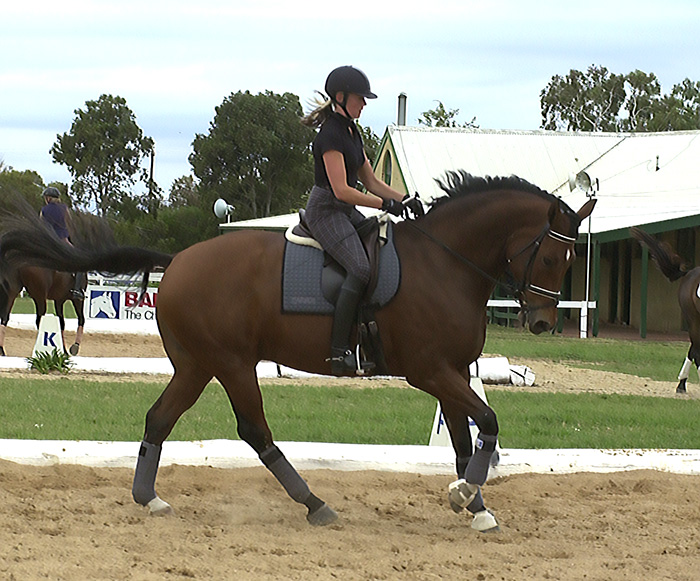
And the lesson ended on a happy, forward free note.
story follows advertisement
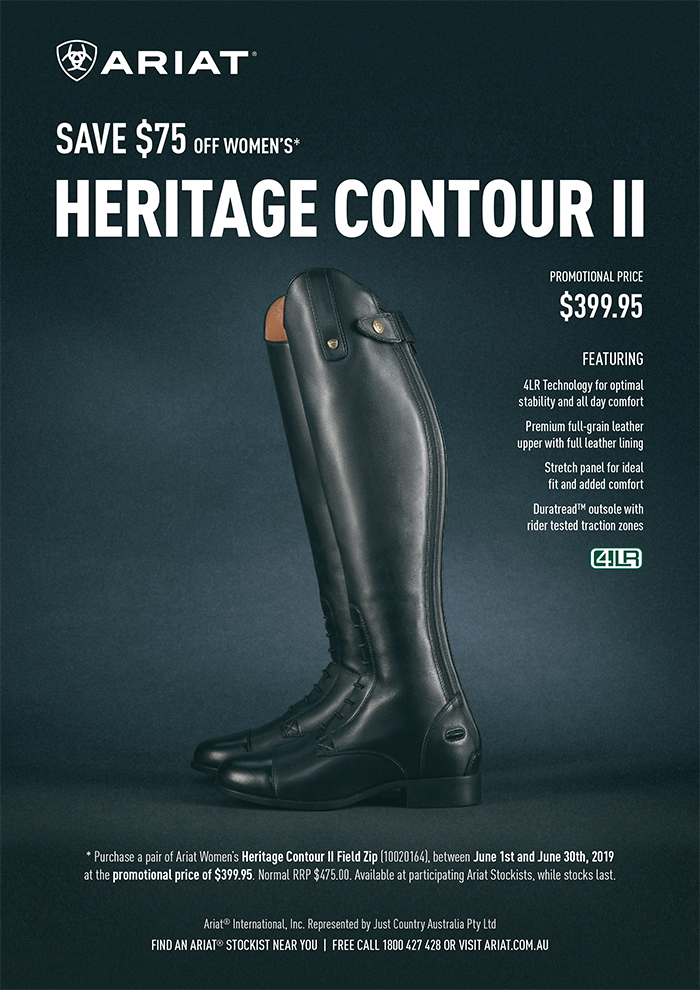
Rebecca had a bit of a good time / bad time of it at the Dressage championships. She rode a sweet first Elementary test, but thought she’d under-rode it a bit. The cry went out for Dr MacMillan, could she please come and work Bec and Whistler in for the Medium. Ricky was only to happy to help…
As Ricky remarked as she watched Bec’s Medium test, part of the problem is that Rebecca is so tough on herself: “What I was trying to do in the warm-up was encourage her to be confident. And get the horse out a little more through correct half halts, while keeping the back end under. Just to get the half halts in the balance because he is really an elementary horse except she is riding him medium. So she needs to be helping him with her half halts.”
Do riders need someone to work them in?
“They certainly do. If the rider has faith in the trainer then I think it is tremendous to have those eyes on the ground. How much ‘up’ aufrichtung can you manage in the balance? How much more ‘under’ can you ask for safely? Even as a sounding board to re-assure the rider, the person on the ground is the safety catch.”
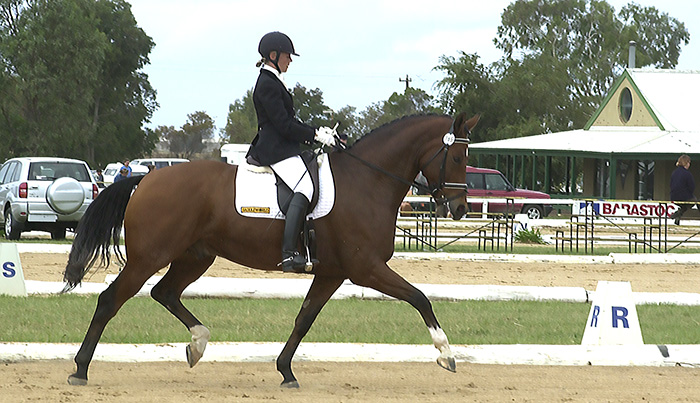
Looking at the test Ricky maintained a running commentary: “Almost straight at the halt, but not quite square. Nice balance in the corner, after the first horse length the diagonal the trot was absolutely super. There was a bit of a wobble on the centre line there, I’m not quite sure what we were doing. The problem is that the work is not consistent. There are moments when it is super but it is not consistent. This is a confidence thing for Becky, it is a big ask for her, because he is just ready for medium. With more experience she would be able to use more, smaller, half halts.”
“She is tending to wait too long for the half halt. She’s just not confident with them. It is not that they are not going through, perhaps she is asking too much and he is not sure. But he has super rhythm and very good hind legs, and that is everything. You can forgive just about anything if they’ve got those hind legs.”
“Again not consistent in the contact in the rein back, and I’m sure that is just confidence. Nice walk, in the warm up she did some excellent collected walk. She has the tendency to collapse her left seat bone, left hip, and I guess that is when she gets into trouble with her left hand. She is such an elegant rider, there are just a few little things.”
And there is a little hump through the flying change…
“That was the left hand, he didn’t have anywhere to go. Just a little problem with communication. So nice the canter walk… He is really not quite ready, so this is just collected canter. It would be fine in elementary but it is not quite enough at this level. Now he is getting a little tight in his back…”
And of course, horses being horses, Whistler does his best flying change when he should have been doing counter canter! And then when the change came, there was another little kick up.
“She didn’t have the balance in the canter, he was on the forehand – and it is very difficult to decide when to apply the aids when the horse is on the forehand. If the horse is leaning in your hand, there isn’t actually a moment. So the horse reacted strongly to her aid, when what she needed was the half halt, get him up, give, then ask for the flying change, and there just wasn’t time for her. When they are leaning in your hand it is hard because there is no clear moment of suspension in which to give the aid. It is just experience and forming the partnership a little more. You get the feeling that you are looking at something that could have been the winner today but there were far too many marks thrown away…”
“The trouble is that the rider waits too long to come with the half halt, she waits until the horse is very much on the forehand before she comes with the half halt. The half halt is almost the last resort and it should be much earlier, then it can be smaller. When the horse is pulling you out of the saddle, it is difficult to find the timing you need.”
Do you like teaching?
“I have to admit that I do. I don’t have enough time to do it, but I enjoy it, so I do it. I would be better off riding my horses…”
